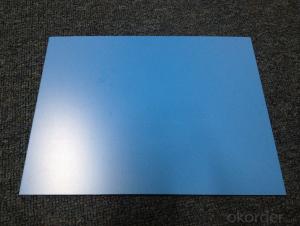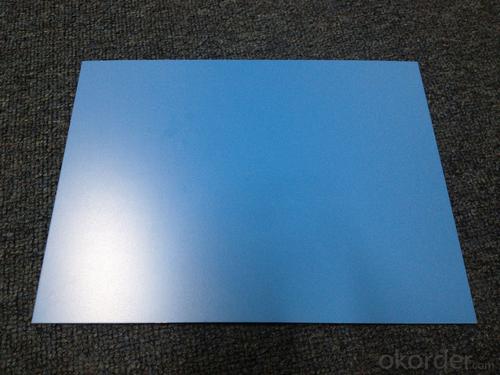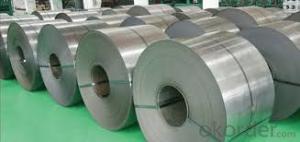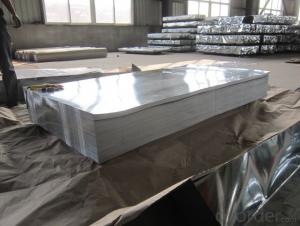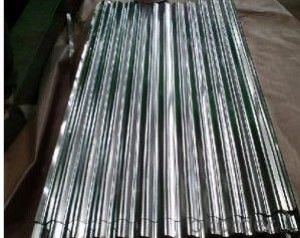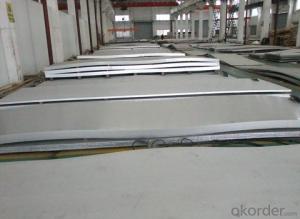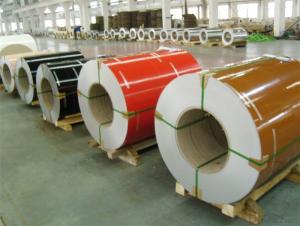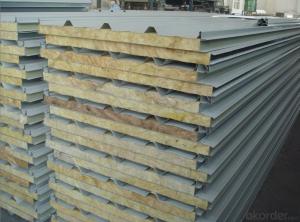HJ PRE-PAINTED ALUZINC STEEL SHEET
- Loading Port:
- Tianjin
- Payment Terms:
- TT OR LC
- Min Order Qty:
- -
- Supply Capability:
- 8000 m.t./month
OKorder Service Pledge
OKorder Financial Service
You Might Also Like
PRE-PAINTED ALUZINC STEEL SHEET
THICKNESS:0.18mm-1.5mm
WIDTH:900mm-1250mm
COATING MASS:AZ30-AZ180
PAINT:PE、HP、HDP、PVDF、SMP、MATT、PVDF
COLOR:RAL Scale
COIL INNER DIAMETER:508mm/610mm
COIL WEIGHT:3mt-7mt
BASE MATERIAL:Hot-dip Aluzinc Steel
Cold rolled plate of color coating steel plate
From the color plate cold rolling board production, has smooth and beautifulappearance, processing performance and has cold rolling board; but any tinyscratch the surface coating will put cold-rolled base plate is exposed in the air,so that the exposed iron quickly generated red rust. Therefore, this kind ofproduct can only be used for less demanding the temporary isolationmeasures and indoor materials.
Hot dip galvanized color coating steel plate
The organic paint coating on hot dip galvanized steel sheet on products for hotgalvanizing and coating plate. Hot dip galvanized Caitu besides the protective effect with zinc, organic coating on the surface also played isolation protection,prevent rust role, the service life is longer than the heat galvanized plate. The zinc content of hot dip galvanized substrate for general 180g/m2 (double),building external hot galvanized substrate galvanized weight up to 275g/m2.
Hot-dip zinc coated board
According to the requirement, also can use hot aluminium zinc plate as coating substrates (55%AI-Zn and 5%AI-Zn).
Electro galvanized and color coated sheet
Electricity galvanized plate as a substrate, coated with organic coating bakingincome products for electric galvanized Caitu, because the electric galvanized plate the zinc layer is thin, often containing zinc quantity is 20/20g/m2, theproduct is not suitable for production use in outdoor walls, roof. But because of its beautiful appearance and excellent processing performance, so it can be mainly used in household appliances, audio equipment, steel furniture, interior decoration, etc..
- Q: Are the steel sheets heat-resistant?
- Indeed, steel sheets exhibit remarkable resistance to heat. Renowned for its elevated melting point, steel proves to be an apt substance for situations that entail exposure to extreme temperatures. It possesses the ability to endure heat without distorting or compromising its structural integrity. Nonetheless, the precise extent of this heat resistance may fluctuate contingent upon the distinct variety of steel and its composition. Certain steel alloys are intentionally formulated to possess an even greater resistance to heat, rendering them suitable for implementation in sectors like aerospace, automotive, and construction, where elevated temperature environments are prevalent.
- Q: How do you cut a steel sheet?
- In order to cut a steel sheet, it is necessary to utilize the correct tools and techniques. The following are several commonly employed methods: 1. Power tools: An angle grinder equipped with a cutting disc is the most frequently used power tool for cutting steel sheets. While operating the grinder, it is essential to wear safety goggles and gloves. Begin by marking the cutting line on the sheet using a marker or chalk. Then, slowly and steadily maneuver the grinder along the marked line to cut through the steel. 2. Shears: For thin steel sheets, manual or electric shears can be employed. These tools possess a scissor-like cutting mechanism specifically designed for cutting metal. Position the steel sheet between the shears' blades, aligning the cutting line with them, and apply consistent pressure to cut through the sheet. 3. Plasma cutting: This technique is most suitable for thicker steel sheets. Plasma cutting involves the utilization of a high-velocity jet of ionized gas (plasma) to melt and sever the metal. Specialized equipment, such as a plasma cutter utilizing an electric arc to generate the plasma jet, is necessary for this method. 4. Waterjet cutting: Another effective method for cutting steel sheets is waterjet cutting. This method employs a high-pressure jet of water mixed with an abrasive substance, such as garnet, to cut through the metal. Although this technique is ideal for intricate shapes and precise cuts, it requires specialized machinery. Prioritizing safety is of utmost importance before attempting to cut a steel sheet. It is crucial to wear suitable protective gear, like safety glasses, gloves, and, if necessary, a face shield. Additionally, ensure that the work area is well-ventilated to prevent inhaling any fumes or particles produced during the cutting process.
- Q: How are steel sheets protected during storage in humid environments?
- Corrosion prevention is a common practice used to protect steel sheets stored in humid environments. This involves implementing various measures to minimize the steel sheets' exposure to moisture and humidity, which are the main contributors to corrosion. One effective method is applying a protective coating to the steel sheets. This coating acts as a barrier between the steel and the surrounding moisture, preventing direct contact and reducing the risk of corrosion. Depending on the specific requirements and conditions of the storage environment, different types of coatings, such as paint, oil, or specialized corrosion-resistant coatings, can be used. In addition to protective coatings, steel sheets can also be stored in a controlled environment with regulated temperature and humidity levels. This helps to reduce the amount of moisture in the air surrounding the steel sheets, thereby decreasing the likelihood of corrosion. Dehumidifiers or climate-controlled storage facilities can be utilized to achieve this controlled environment. Proper handling and packaging of the steel sheets also play a crucial role in their protection during storage in humid environments. It is important to store the sheets in a manner that allows for adequate airflow and ventilation to minimize moisture accumulation. Additionally, packaging materials, such as plastic wraps or moisture-resistant packaging materials, can provide an extra layer of protection against moisture. Regular inspection and maintenance are essential to ensure the ongoing protection of steel sheets during storage in humid environments. This includes regularly checking for signs of corrosion or damage and promptly addressing them to prevent further deterioration. In conclusion, a combination of protective coatings, controlled storage environments, proper handling, and regular maintenance are necessary to safeguard steel sheets from the negative effects of humidity and moisture during storage.
- Q: Do the steel sheets have any specific certifications?
- Yes, the steel sheets have specific certifications.
- Q: What are the different types of surface finishes available for steel sheets?
- Steel sheets come in a variety of surface finishes, each with its own purposes and aesthetic qualities. Some of the most common finishes include: 1. Hot rolled: Achieved by heating the steel and then rolling it, this finish creates a rough texture. It is commonly used for structural purposes where appearance is not the main concern. 2. Cold rolled: Unlike hot rolled, this finish is achieved at room temperature, resulting in a smoother and more refined surface. It is often used for applications that require precision or a visually appealing appearance. 3. Galvanized: Steel sheets are coated with a layer of zinc to provide excellent corrosion resistance. This finish is commonly used in outdoor or high-moisture environments. 4. Electro-galvanized: Similar to galvanized, this finish involves depositing a layer of zinc using an electrical current. It creates a thinner and more uniform coating. 5. Stainless steel: Chromium is added to the steel sheets to create a protective layer that prevents corrosion and staining. Stainless steel is known for its strength and resistance to chemicals, making it suitable for various applications. 6. Satin: This finish is achieved by brushing the steel surface with abrasive materials, resulting in a smooth and low-reflective appearance. It is commonly used for architectural and decorative purposes. 7. Mirror: Steel sheets with a mirror finish have a highly reflective surface achieved through progressive polishing. This finish is often used in decorative applications. 8. Painted: Steel sheets can be coated with paint to improve appearance and provide additional protection against corrosion. This finish offers a wide range of color options and customization possibilities. These are just a few examples of the available surface finishes for steel sheets. The choice of finish depends on the specific requirements of the application, including aesthetics, corrosion resistance, and functionality.
- Q: Can steel sheets be used in outdoor applications?
- Steel sheets are a great option for outdoor applications. They possess exceptional durability and strength, enabling them to withstand diverse weather conditions, thus rendering them suitable for outdoor use. The construction industry heavily relies on steel sheets for roofing, siding, and cladding purposes. Additionally, they are extensively utilized in outdoor storage sheds, fences, and gates. To enhance its corrosion resistance against moisture and environmental elements, steel sheets can be coated with galvanization or painting. Consequently, their ability to withstand exposure to such factors is greatly improved. All in all, steel sheets are an exceedingly dependable choice for outdoor applications, thanks to their strength, durability, and versatility.
- Q: What are the different sheet metal bending techniques for steel sheets?
- There are several sheet metal bending techniques commonly used for steel sheets. These techniques allow for the manipulation and shaping of steel sheets to achieve desired forms and angles. Some of the most common techniques include: 1. V-bending: This technique involves using a V-shaped punch and die set to create a sharp bend in the steel sheet. The material is placed between the punch and die, and force is applied to form the desired angle. V-bending is a versatile technique that can create various angles and shapes. 2. Air bending: In this technique, a punch is used to press the steel sheet into a V-shaped die, but without completely contacting the material. The bending is achieved by controlling the depth of penetration of the punch into the material. Air bending allows for greater flexibility in terms of angle adjustments and requires less force than other techniques. 3. Edge bending: As the name suggests, this technique involves bending the edge of the steel sheet. It is commonly used to create flanges or edges with specific angles. Edge bending is achieved by clamping the sheet between a punch and a die, and applying force to bend the material along the edge. 4. Bottom bending: This technique is used to create larger bends in steel sheets. It involves clamping the sheet between a punch and a V-shaped die, and then applying force to bend the material around the die. Bottom bending is suitable for creating U-shaped parts or boxes. 5. Roll bending: Also known as cylindrical bending, this technique is used to create cylindrical or curved shapes in steel sheets. The sheet is passed through a set of rolls, which gradually bend the material into the desired shape. Roll bending is commonly used in the production of pipes, tubes, and cylinders. 6. Coining: Coining is a precision bending technique that creates crisp, sharp bends. It involves pressing the steel sheet between a punch and a die, with the die featuring a sharp edge. The material is subjected to high pressure, resulting in a precise and defined bend. These are just a few of the many sheet metal bending techniques available for steel sheets. Each technique has its advantages and applications, and the choice of technique depends on factors such as the desired angle, the thickness of the sheet, and the complexity of the shape being formed.
- Q: How do steel sheets handle chemical exposure?
- Steel sheets are known for their excellent resistance to chemical exposure. They are highly resistant to corrosion and can withstand exposure to a wide range of chemicals, including acids, alkalis, solvents, and other corrosive substances. This is mainly due to the protective oxide layer that forms on the surface of steel, known as patina, which acts as a barrier against chemical attack. Furthermore, steel sheets can be further protected by applying a variety of protective coatings such as galvanization, epoxy coatings, or powder coatings. These coatings provide an additional layer of protection and enhance the steel's resistance to chemical exposure. However, it is important to note that the resistance of steel sheets to chemical exposure can vary depending on the specific type and concentration of chemicals involved. Highly concentrated or aggressive chemicals may still cause some degree of corrosion or damage to the steel surface over time. Therefore, it is crucial to consider the specific chemical environment and select the appropriate grade of steel and protective coating to ensure maximum resistance to chemical exposure. Overall, steel sheets are a reliable and durable material choice for applications that require resistance to chemical exposure. With proper selection and maintenance, they can effectively handle various chemical environments and provide long-lasting performance.
- Q: Are steel sheets suitable for structural applications?
- Yes, steel sheets are suitable for structural applications. Steel sheets are known for their high strength, durability, and ability to withstand heavy loads, making them an ideal choice for various structural applications such as bridges, buildings, and industrial structures.
- Q: What are the different testing methods for steel sheets?
- There are several testing methods for steel sheets, including tensile testing, hardness testing, impact testing, and bend testing. Tensile testing measures the maximum amount of stress a steel sheet can withstand before breaking. Hardness testing determines the resistance of the steel sheet to indentation or scratching. Impact testing assesses the ability of the steel sheet to withstand sudden or dynamic loads. Bend testing evaluates the flexibility and ductility of the steel sheet by subjecting it to a specified degree of bending without fracture. These testing methods help ensure the quality and performance of steel sheets in various applications.
Send your message to us
HJ PRE-PAINTED ALUZINC STEEL SHEET
- Loading Port:
- Tianjin
- Payment Terms:
- TT OR LC
- Min Order Qty:
- -
- Supply Capability:
- 8000 m.t./month
OKorder Service Pledge
OKorder Financial Service
Similar products
Hot products
Hot Searches
Related keywords
